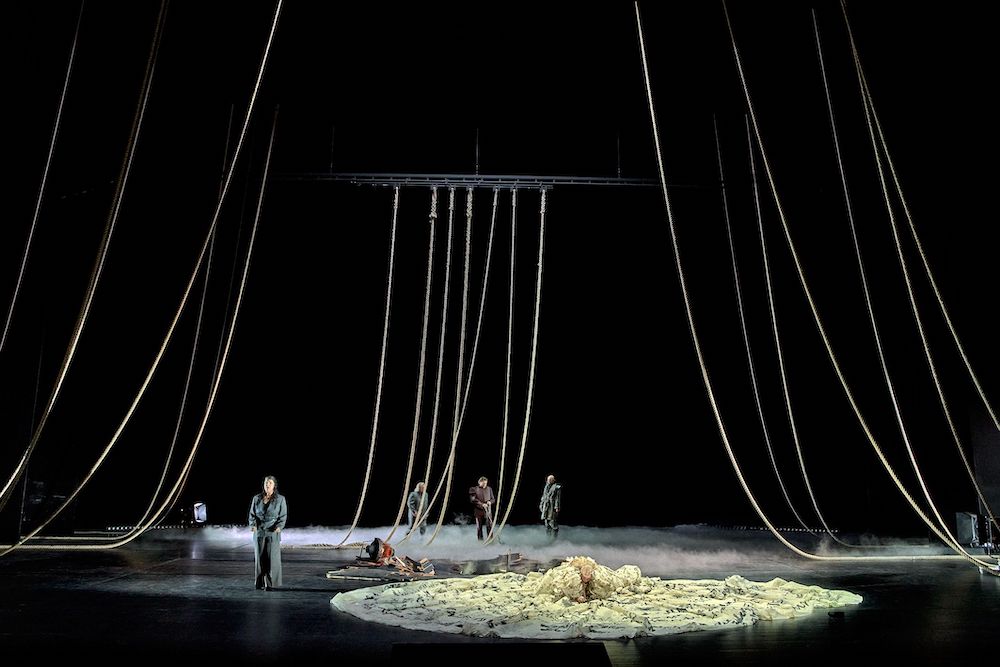It is a Tristan well worthy of the Wagner shrine (not all Bayreuth productions are). Icelandic theater director Thorleifur Örn Arnarsson imposed a truly hermetic discussion of love onto the Wagner masterpiece in the rarefied theatrical terms of Berlin’s hyper avant-garde Volksbuhne (of which he was a recent artistic director).
Richard Wagner’s unique Bayreuth Festspielhaus hides the orchestra under the stage, voice and orchestral sound flow into the hall as one. The Bayreuth cast was peerless, the orchestra shone in the theater’s acoustical magnificence. Czech conductor Semyon Bychkov accommodated the highly inflected text with an equally highly inflected orchestral score — voice and sound symbiotic, in complex textures that magically challenged the ear.
The stage itself challenged the mind — Isolde in white wings on a huge white cloth (clouds or the boiling sea) on a blank stage in the first act, in the second Isolde and Tristan were lost in the ruined hull of a ship, a cluttered attic of earthly items. The third act emptied much of the attic, leaving only some sculptural bones of its hull that basked in the transcendent light of a golden Liebestod.

There was no synopsis in the program booklet, only an explanation of how Tristan and Isolde found themselves together on a ship to Cornwall, and an essay by Nike Wagner (Wieland’s daughter) who notes that “if Thomas Mann thought that Tristan, not unlike the Ring, conceals a ‘cosmogonic myth’ he must be corrected insofar as this cosmogonic myth, in the end, is concealed through compositional measures that guarantee regression.”
Be that as it may, the Arnarsson production played heavily on the complexities of love — its deceits and deceptions that are the sum of the first act, the paradox of the second act when the union of love is the death of the lovers, and the third act when Isolde has in fact has failed to lead Tristan to the death she had promised him when their gazes first met — all this before this Wagnerian treatise began.
The above Tristan primer is the manifest of this Arnarsson staging, enacted in small, subtle, symbolic gestures and images that were felt rather than defined — Isolde entrapped within her cloud in the first act Tristan tearing papers apart in the second act, the white dressed steersman with wings appearing and disappearing in the third act — to mention the more obvious of the plethora of images of separation and death.
There were blatant departures from Wagner’s stage directions, departures that illuminate the critical discussions that this Wagnerian opera has engendered over the past 168 years — we are well aware that this opera is not the same opera it was in 1857. In the first act Isolde tore the flask of poison/love potion from Tristan and threw it across the stage — the original gaze was in fact the Tristan death poison (in the opera’s pre-history Isolde was about to kill Tristan when their eyes met in the gaze of immortal love). The second act ends not with Melot wounding Tristan but with Tristan drinking the potion Isolde had given him to heal his wound in the pre-opera history, thus again saving him only to endure her promised love death.
The intended force of these images and their shattering effects determined that much of the stage action was static, the singers left alone to intone the text, to inflect the text with subtleties of intention that was subservient to the philosophic imagery perceived by Aransson and contemporary Wagnerian criticism.
Much the same process occurred in conductor Bychkov’s reading of the score. If the perception was that the progression of text (stage action) was slow, nearly static (and indeed it was), so were the maestro’s tempi. But the slowness brought forth the revelation of colors from within the depths of Wagner’s orchestration, often forcing apart the orchestral sounds from the voice sounds in the shattering chromatic dissonances of separation. This the antithesis of the conjunction of love that was once thought to be the proclamation of Wagner’s Tristan and Isolde.
Freed to declaim Wagner’s text the singers inflected the text, often sacrificing an expected musical flow. The moments of illumination they felt flew easily, the deceits were spat, the joy was shouted, the negotiations were brutal. Of great moment was the Tristan of Austrian tenor Andreas Schrager (lead photo with Kurwenal) who drew upon his myriad voices to create a Tristan of monumental dimension, from an intoned speaking voice to full throttled shouts of joyous illumination in his third act recalls of the conjunction he might have had with Isolde. In the second act his emphatic accents as the excitement of love-death approached were truly momentous.

Isolde was enacted by Norwegian soprano Camilla Nylund, who crawled across the stage to sing her “Liebestod” propped up against a broken ship beam, the stage of broken ship beams bathed in golden light, the stage platform itself floating on golden light. Mme. Nylund possesses a quite beautiful voice of silvery color. With soaring high notes she found as well the vehemence needed for her Act I condemnation of Tristan.
Marke was sung by Austrian bass Günther Groissböch who delivered his famed Act II soliloquy with lieder delicacy, inflected with such grace as to render it timeless. Icelandic baritone Ólafur Sigurdarson was the beautifully voiced Kurwenal, lending authority to Tristan’s plight as Wagner required. Brangäne was sung by Austrian mezzo-soprano Crista Mayer in great warmth and power of tone. Bass baritone Birger Radde, in black pants and a fancy black shirt, flashed impressively on-stage as Melot in the finales of Acts II and III.
The sets were designed by frequent Arnarsson collaborator Vytautas Narbutas. Lighting designer Sascha Zauner was the Arnarsson collaborator for the recent Parsifal in Hannover. Costumes were created by Arnarsson collaborator Sibylle Wallum.
Michael Milenski
Festspielhaus, Bayreuth, Germany, August 9, 2024. All photos copyright Enrico Nawroth, courtesy of the Bayreuth Festival.